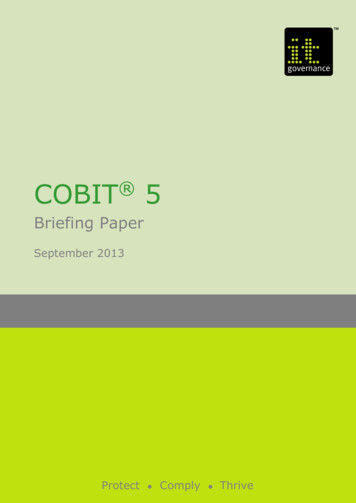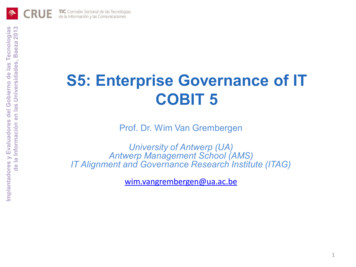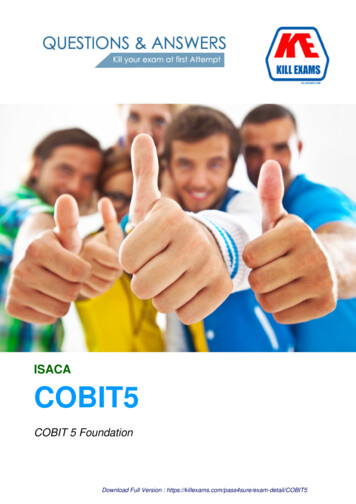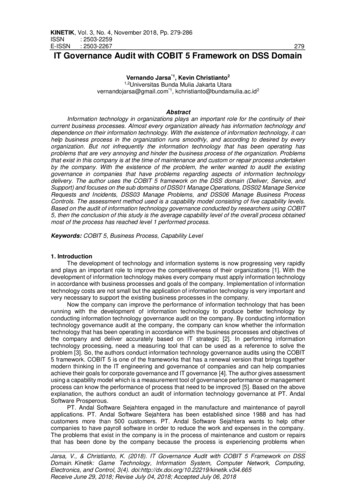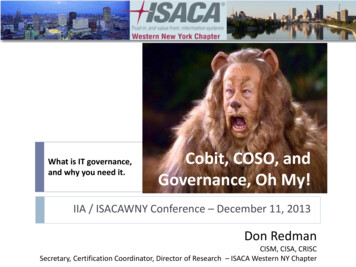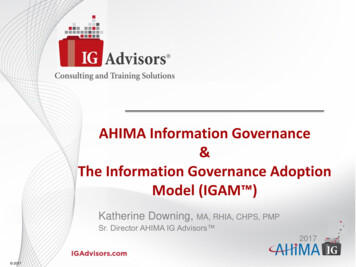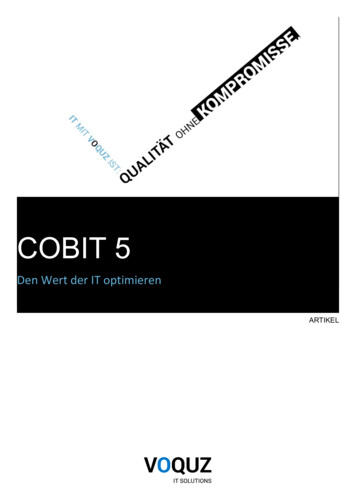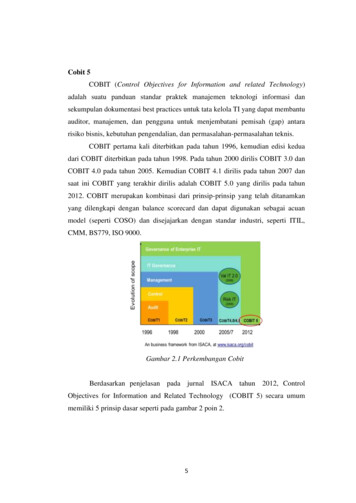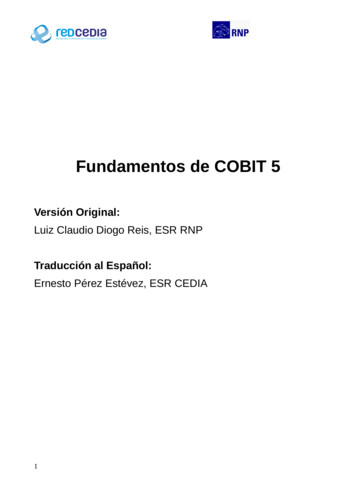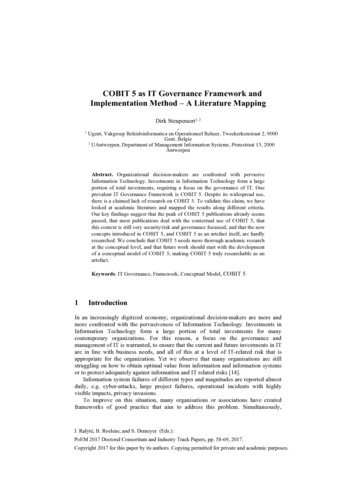
Transcription
COBIT 5 as IT Governance Framework andImplementation Method – A Literature MappingDirk Steuperaert1, 2,1Ugent, Vakgroep Beleidsinformatica en Operationeel Beheer, Tweekerkenstraat 2, 9000Gent, Belgie2UAntwerpen, Department of Management Information Systems, Prinsstraat 13, 2000AntwerpenAbstract. Organizational decision-makers are confronted with pervasiveInformation Technology. Investments in Information Technology form a largeportion of total investments, requiring a focus on the governance of IT. Oneprevalent IT Governance Framework is COBIT 5. Despite its widespread use,there is a claimed lack of research on COBIT 5. To validate this claim, we havelooked at academic literature and mapped the results along different criteria.Our key findings suggest that the peak of COBIT 5 publications already seemspassed, that most publications deal with the contextual use of COBIT 5, thatthis context is still very security/risk and governance focussed, and that the newconcepts introduced in COBIT 5, and COBIT 5 as an artefact itself, are hardlyresearched. We conclude that COBIT 5 needs more thorough academic researchat the conceptual level, and that future work should start with the developmentof a conceptual model of COBIT 5, making COBIT 5 truly researchable as anartefact.Keywords: IT Governance, Framework, Conceptual Model, COBIT 51IntroductionIn an increasingly digitized economy, organizational decision-makers are more andmore confronted with the pervasiveness of Information Technology. Investments inInformation Technology form a large portion of total investments for manycontemporary organizations. For this reason, a focus on the governance andmanagement of IT is warranted, to ensure that the current and future investments in ITare in line with business needs, and all of this at a level of IT-related risk that isappropriate for the organization. Yet we observe that many organisations are stillstruggling on how to obtain optimal value from information and information systemsor to protect adequately against information and IT related risks [14].Information system failures of different types and magnitudes are reported almostdaily, e.g. cyber-attacks, large project failures, operational incidents with highlyvisible impacts, privacy invasions.To improve on this situation, many organisations or associations have createdframeworks of good practice that aim to address this problem. Simultaneously,J. Ralyté, B. Roelens, and S. Demeyer (Eds.):PoEM 2017 Doctoral Consortium and Industry Track Papers, pp. 58-69, 2017.Copyright 2017 for this paper by its authors. Copying permitted for private and academic purposes.
academic research has provided answers on how organizations can implement ITgovernance. The state-of-the-art view in academia is that IT governance should beimplemented as a holistic set of structures, processes, and relational mechanisms.From the practitioner area, guidance has also surfaced. The leading practitionerframework for the governance and management of enterprise IT is developed byISACA (Information Systems Audit and Control Association, Rolling Meadows, IL,USA). The framework is called COBIT (Control Objectives for Information andRelated Technologies), and is currently in its fifth edition1.Referring to Rescher’s methodological pragmatism [10], the claimed wideacceptance of COBIT 5 would suggest it is a successful framework, not requiringfurther validation. Despite the availability and different degrees of adoption ofCOBIT5 and other frameworks, IT related problems persist in many organisations, asproven daily by reported IT problems in the press.This indicates that either the frameworks themselves are not complete or ofsufficient quality yet, and/or that operationalising the guidance from theseframeworks is not successful. Both potential sources of failure (inadequateframeworks and/or implementation failures) need to be better understood beforeimprovements to the good practices and/or their implementation can be proposed.Indeed, COBIT 5, and by extension other frameworks in the same space, have notbeen the subject to extensive scientific research yet. De Haes et al. [5] indicatemultiple areas for potential research, one being the study of COBIT 5 as an artefact,which would include understanding how the pragmatic foundations of COBIT 5 canbe supported by existing Information Management and Governance theories [15].Within this context, section 2 introduces the objective of the research presented inthis paper. Section 3 details our research methodology. Section 4 presents the findingswhich are subsequently discussed in section 5, where directions for further researchare also provided.2Objective and Research QuestionThe goal of this literature mapping paper is to understand the current state of theresearch on COBIT 5. More in particular we would like to learn about:a) the number of publications on COBIT 5;b) to what extent and what purpose COBIT 5 is referenced in the publications;c) how the current research relates to the observed problems with IT Governanceand the identified research gaps [5];d) the specific context in which COBIT 5 is researched;e) which aspects of IT Governance (as per COBIT’s own definition of this term)are covered;f) the industry sector coverage of the research;g) coverage of the key characteristic of COBIT 5 – the Enabler concept;The most important goal of our analysis is to help us to understand potentialreasons for any identified research gaps.1www.isaca.org/COBIT59
3Methodology and Search StrategyWe used the following search strategy to identify research on COBIT 5 in theacademic literature.1. Search for references as of 2012, i.e. the publication date of COBIT 5, the mostrecent version of COBIT. The reason for this limitation is that COBIT 5 containssubstantial differences compared to its predecessor COBIT 4.1, including anextended architecture (enabler-focus instead of process focus, a very differentprocess capability mechanism, restructured and updated process guidance, anupdated goals-based prioritisation mechanism, and more. For that reason, webelieve that for the purpose of this research articles dating before 2012 and/orreferring to earlier versions of COBIT are less relevant.2. Search on Web of Science (WoS) academic articles for our literature mapping. Thechoice for WoS was made under the assumption that publications listed in WoSpassed through a peer review process, hence guaranteeing a minimum level ofresearch quality. For that purpose, we again searched for articles published in 2012and later, and we included both journal articles and conference proceedings in oursearch. We performed three searches, i.e.a.b.c.Search on “IT Governance” and a number of equivalent terms, in order togenerally understand the number of IT Governance related publicationsA search on COBIT2, in order to obtain the set of articles for our review.COBIT 5 is marketed (and marked) as an IT Governance Framework. At thesame time, it is not the only one such framework, and for that reason weexpect the number of articles to be found here to be smaller than, but in thesame order of magnitude as the number in a).To further confirm the overall reasonableness of the found set of articles weperformed a search on “COBIT” and “Governance” to ensure that themajority of the found set of articles on COBIT was also dealing withGovernance. The expectation there was that the found number should besmaller but again in the same order of magnitude as the number found in b),the reason being that COBIT has other uses (or uses not necessarilydescribed as Governance) also.3. The WoS search results (search date 8 May 2017) as described above are asfollows: There are 317 articles on IT Governance and equivalent terms.There are 133 articles on COBIT, including 81 which contain both terms COBITand Governance.2The search term used is “COBIT” and not “COBIT 5”, because not all articles use the termCOBIT 5 even when the article is about COBIT 5. Since we limit the search to articlespublished in or after 2012, this will not lead to ‘false trues’, or at least only a very few ones.Using the search term “COBIT 5” however resulted in a lot of missed articles.60
Table 1. Found arcticles in Web of ScienceDatabaseWoSWoSWoSSearch String“IT Governance” OR “governance of enterprise IT” OR“ICT Governance” OR “corporate governance of IT”COBIT“Governance” AND “COBIT”#Hits31713381In a first analysis of the set of 133 articles on COBIT, we eliminated the ones thatwere not relevant (dealing with completely off-topic subjects also bearing the COBITacronym but dealing with something completely different), the ones which had nomeaningful information in their abstracts and the duplicates. This filter reduced thenumber of relevant references from 133 to 121.For this literature mapping we analysed the titles and the abstracts of the selectedarticles. This is a common practice in structured literature mapping, which differsfrom structured literature review that analyses the entire paper content [9]. Weincluded both journal articles and conference proceedings articles in our analysis,where the ratio was about 1:3We conducted three walkthroughs of the retained references: the first one to makean initial analysis and to refine our initial classification taxonomy, a secondwalkthrough to complete the classification and a last one for a consistency check.All walkthrough’s (and classifications) were made by one researcher.4Results and Discussion of the Literature Mapping34.1Evolution in number of publicationsLooking at the number of publications per year, we see a steady growth between 2012and 2015, and a sharp decline since then.3For some diagrams percentage numbers may not add up exactly to 100% due to roundingerrors.61
ence Proceedings12017Journal ArticlesFig. 1. Evolution in time of number of publicationsThe number of publications, more in particular conference proceedings, seems tohave surpassed its top; this is unfortunate since the continued existence and use ofCOBIT 5, and the importance of IT Governance and COBIT 5 as one of the preferredimplementation methods.4.2Role of COBIT in publicationsWe classified the publications based on how and for what purpose the COBITFramework is referenced in an article, ranging from mere reference to the subjectitself of the research.For that reason, we defined the following taxonomy for coding the foundliterature: Referenced (R) – COBIT is mentioned as an existing framework or referenced, butis not used to any meaningful extent in the paper. Derived (D) – COBIT is mentioned as an existing framework, and it is used tobuild a new, related framework to deal with IT Governance related or otherissues. Applied (A) – COBIT is used as is, and it is applied to a certain context or with acertain purpose; this covers e.g. application of COBIT to measure processperformance, or to map it against other standards. The difference with the previouscategory is that no new derived framework is constructed and COBIT is used inits current shape and form. Subject (S1 and S2) – IT Governance arrangements (S1) and/or the COBITFramework (S2) are the subject itself of the research. They are most of the time notapplied to any specific context, but rather researched as an artefact itself. This isthe most fundamental research on COBIT possible. Other (O)62
The results of coding the found literature set according to the taxonomy above, isdescribed in the table below:Table 2. Role of COBIT 5 in publications#Papers withrole of Subject 1Subject 2Other123731852Journal e observe that: A significant part (17% 37% 54%) of publications uses COBIT as a reference oras a source for designing a new (proprietary) framework; Only a small proportion of publications researches COBIT or IT Governance as anartefact (8% 6% 14%); closer analysis learns that 10 of those 17 publications didnot deal with COBIT itself (S2), but rather dealt with IT governance models ingeneral (S2). Hence only 7 (out of 121, representing less than 6%) articles arelooking at COBIT 5 as an artefact in some ways; There are differences in the role of COBIT in journal articles versus conferenceproceedings articles, i.e. a larger proportion of journal articles only refers toCOBIT (8 out of 26, or 31% versus only 12 out of 95 or 13% for ConferenceProceedings), and a smaller proportion of journal articles deals with ApplyingCOBIT (6 out of 26 or 23% versus 31 out of 95 or 33% of ConferenceProceedings)When interpreting these observations, we can state that: The large number of articles where COBIT is used as source of inspiration tocreate another framework sends mixed messages. On the one hand this observationsupports the perception that COBIT is a good framework from which one canderive another framework. On the other hand, it also demonstrates that manypeople think that the problems they are facing still require new frameworks derivedfrom existing ones, showing potential problems with generic frameworks (likeCOBIT 5) in their current states. Further research will have to determine the natureof these problems which could include frameworks that are too complex, too highlevel, not specific for their particular context, etc. The absolute low number of publications researching COBIT as an artefactrepresents a major research gap. There have been well substantiated calls for thistype of research by Dehaes et al. [5], De Vos et al.[15], which remain unansweredfor now.63
A possible explanation for the lack of such research could be the lack of formalisedor explicit ‘theory’ or model for the COBIT 5 Framework. See section 4.3 forfurther discussion.4.3Number and type/nature of publicationsWe then analysed the set of publications from a different angle. In the context of ourresearch we propose to differentiate between two types of prob
The leading practitioner framework for the governance and management of enterprise IT is developed by ISACA (Information Systems Audit and Control Association, Rolling Meadows, IL, USA). The framework is called COBIT (Control Objectives for Information and Related Technologies), and is currently in Cited by: 1Publish Year: 2017Author: Dirk Steuperaert
